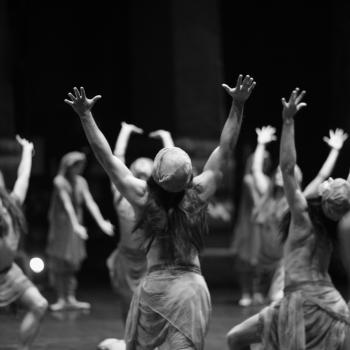 Maybe you’ve heard of the “marshmallow experiment” for testing people’s self-control. In this classic psychology study, scientists offered young children a choice: either eat a single marshmallow immediately, or wait for a few minutes and get to eat two. Findings have shown a remarkable correlation between children’s ability to delay gratification and a plethora of positive outcomes later in life, from higher SAT scores to better physical health. But where does self-control come from in the first place? A new study published in the journal Child Development suggests that one answer may be “rituals.” Specifically, children who played a complex, ritualized game many times over a three-month span showed improved self-control afterwards – and, crucially, this effect was strongest for children who heard no practical justification for the game’s rules.
Maybe you’ve heard of the “marshmallow experiment” for testing people’s self-control. In this classic psychology study, scientists offered young children a choice: either eat a single marshmallow immediately, or wait for a few minutes and get to eat two. Findings have shown a remarkable correlation between children’s ability to delay gratification and a plethora of positive outcomes later in life, from higher SAT scores to better physical health. But where does self-control come from in the first place? A new study published in the journal Child Development suggests that one answer may be “rituals.” Specifically, children who played a complex, ritualized game many times over a three-month span showed improved self-control afterwards – and, crucially, this effect was strongest for children who heard no practical justification for the game’s rules.
The premise of the study was simple enough. Humans depend on self-control and self-regulation to focus on goals and live successfully. But while we might intuitively associate self-control with practical goals such as studying for a big test, many of the contexts that require the most self-control can actually be social or cultural – such as observing protocol during a meeting or participating in a religious ritual. So the authors of the study, led by Oxford psychologist Veronika Rybanska, posited that rituals and social conventions might be more effective than everyday practical skills at building self-control.
Their reasoning stemmed from the fact that many cultural conventions and rituals, such as religious rites, are both complicated and arbitrary. Learning and mastering them demands a lot of focus, dedication, and attention – in fact, even more focus and concentration than learning a practical skill like splitting wood. Why? Because practical skills aren’t arbitrary. Instead, they’re aimed at accomplishing a particular objective. And since the point of a practical skill is to get the thing done – not how it gets done – one can often do it in any number of different ways. As such, a newbie doesn’t always have to be perfectly accurate in imitating her teacher when learning a purely instrumental skill.
On the other hand, a ritual typically has to be copied exactly, so the person learning the ritual needs to be very attentive and precise in imitating the teacher – precisely because the point of a ritual isn’t to accomplish any particular practical objective, but simply to be done. Thus, learning how to do a ritual can require more careful attention to particular steps and subtle actions than learning a mundane skill does.
In cognitive scientific terms, a focus on the particular, practical reasons for an action is called the “instrumental stance,” while a focus on simply following the particular, step-by-step motions of a given convention is called the “ritual stance.” Rybanska and her colleagues predicted that the ritual stance would activate – and thereby improve – executive cognitive functioning such as attention, working memory, and response inhibition, because ritual demands such a high degree of fidelity in imitation. And since exercising executive functions can improve them over the long term, the ritual stance might be able to boost self-control if engaged over the period of weeks or months.
To test this hypothesis, Rybanska and her colleagues recruited 110 children in Slovakia and 105 children in Vanuatu, a Pacific island nation with a population of around 260,000. The decision to use subjects from two different societies was a way of ensuring that any findings wouldn’t be applicable only to people from Western, educated, industrialized, rich, and democratic (WEIRD) countries. Vanuatu is more traditionalistic and collectivistic, with higher expectations for adherence to social norms, than Slovakia. Since the two nations differ in the extent to which they emphasize ritual and conventionalism, the experimenters thought that the ritual stance might have different effects in the two countries. Children at both field sites received instructions in their native languages (Slovakian in Slovakia, and an English-based creole language called Bislama in Vanuatu).
At the beginning of the study, about half of the children were tested for baseline executive function. Children were first told to touch their head, toes, knees, and shoulders on cues from the experimenter. Then, they were told to switch their responses, so that when the experimenter said, for example, “head,” they would need to touch their toes. Better performance on this task indicated that children had better attention control, working memory, and inhibition control. Then those same children were given a version of the marshmallow task, in which they were given a single piece of candy and told they could either eat it after the experimenter left the room, or wait until the experimenter returned – in which case they would receive two pieces of candy. The marshmallow (candy) task measured delay of gratification.
Only half the children in each location were given these pretests in order to control for any effects that the pretests themselves might have on self-control and executive function. Then, half the children in each group were randomly assigned to the experimental condition, with half of those in turn being assigned to the instrumental condition or the ritual condition. In total, around 25 children each were assigned to the ritual condition in Slovakia and Vanuatu, and 25 each to the instrumental condition. The other 50 or so children in each country were assigned to the control (non-experimental) condition.
In all experimental groups, children played “circle time games” regularly with experimenters over the course of three months. These games were designed to be complicated and challenging, and to require lots of focus and attention. For example, in one game, called “Red Light, Purple Light,” children were supposed to stop moving when the experimenter held up a purple sign, and to start moving when they saw an orange sign. But the instructions would change – orange might become the sign for stop and purple the sign for go. Additionally, the experimenters added shaped signs that took on different meanings (for example, a circle sign of any color might mean stop, while a square sign might mean go).
For the ritual stance condition, experimenters offered gnomic, non-rational explanations for the complex rules of the circle time games: for example, they told the children that they must keep track of and obey the shifting rules of the games because “it has always been done this way.” Conversely, for the instrumental stance condition the experimenters gave children rational reasons for the rules, such as “if we do it this way, we will learn how to dance.” They predicted that, while all children engaging in the circle time games would improve in executive cognitive function and self-control over the three-month period, those who received only explanations such as “it has always been done this way” would improve even more, since the activation of the ritual stance would lead them to focus more closely on the particular details of the rules.
After the three months were up, all children – those who had received pretests and those who hadn’t, as well as those who had participated in the experimental condition and those who were controls – were measured for executive function and self-control, using the same methods as the pretest. As expected, children who participated in the circle time games over the three-month period performed significantly better on both the head-and-toes task and the marshmallow task than children who’d been in the control groups. Thus, the team successfully replicated previous results showing that long-term practice can improve executive cognitive functions and self-control. In itself, this was a kind of triumph, given the recent (and very much ongoing) replicability crisis in psychology.
But more interestingly, the data corroborated the researchers’ main hypothesis. Children in the ritual condition, who had received only normative appeals to convention as explanation for the circle time games’ arcane rules, performed better on both the head-and-toes task and the marshmallow task than children in the instrumental condition after the three-month period was up. In other words, children who had been led to believe that the rules of the complicated games were akin to ritual – that is, not aimed at accomplishing any instrumental goal, and legitimated solely by cultural convention – improved more in self-control than children who thought the rules had logical, rational explanations.
Rybanska and her colleagues also found that self-control on the marshmallow task was a direct consequence of better executive function on the head-and-toes task. Put another way, activating the ritual stance many times over the course of three months had a positive effect on children’s executive cognitive abilities, and these heightened executive functions led, in turn, to better self-control and delay of gratification. Overall, all findings applied equally to subjects in both Slovakia and Vanuatu.
This study’s findings are a big deal. Other researchers, including myself, have argued that participation in ritual has unique benefits for self-control and self-regulation, above and beyond just the normal rigor of carrying out practical tasks. But until now, these claims have mostly been either theoretical or based on self-report measures of self-control. In other words, the evidence that ritual practice improves self-control has been intriguing, but not conclusive. Now, Rybanska and her colleagues have effectively put the burden of proof on those who argue that ritual has no influence on self-control.
Looking further out towards the horizon, these findings have vivid implications for our understanding of the human brain’s evolution and of our nature as social animals. Researchers such as Robin Dunbar have long argued that the human brain grew to be disproportionately large in order to keep track of the complex social relationships that form the basis of tribal life. But Rybanska et al.’s findings hint that our big brains might have also emerged from our need for ritual and convention. After all, everyday details of behavior and protocol differ widely from group to group. It makes sense that it would take a lot of cognitive energy to learn the all the complex details of behavior and social ritual that distinguish your tribe from your neighbors’. We might have evolved our capacity for self-control, then, in large part to manage the unique – and contingent – demands of living in social groups whose conventions, norms, and rituals are by definition unpredictable but absolutely necessary to learn.
What’s more, our self-regulation abilities may be much more influenced by our social contexts than we think. Could it be that humans need relatively intact cultural norms and conventions to develop adequate self-control? Rybanska and her colleagues seem to think so. In fact, they warn that modern Western society, with its emphasis on individualism and its dismissive attitude toward tradition, may be undercutting young people’s ability to learn self-regulation:
As well as gaining competence in various technical instrumental skills, children also need to acquire the normative conventions of their surrounding communities in order to achieve group acceptance, respect, or influence.…The irony may be that in devising strategies for parenting and schooling geared to a world of rapid technological change while neglecting the importance of traditional cultural practices, we may be contributing to a deterioration of young people’s attentive and inhibitive resources.
Of course, a number of other requirements of modern life probably can – and do – build self-regulation skills, especially education and career demands. You can’t complete a college degree at a respectable school without quite a lot of self-discipline, no matter how individualistic or secular you might be. But Rybanska and her colleagues are probably onto something when they point out the unique role of cultural conventions and rituals in building self-control and executive function.
In a world that’s increasingly distancing itself from any normative hold that cultural traditions once held, the consequences could be serious – especially for those unlucky members of our societies who don’t have clearly defined educational or career pathways. Considering that the middle class is shrinking and inequality growing in nearly all rich societies, we may need to be concerned about what happens when a critical mass of people don’t have either the cultural traditions or the professional demands that could inculcate self-regulation and delayed gratification. In a species adapted to learn and follow social conventions and to take part in cultural rituals, the vacuum of norms that characterizes life in many rich, democratic societies may be a warning sign.












